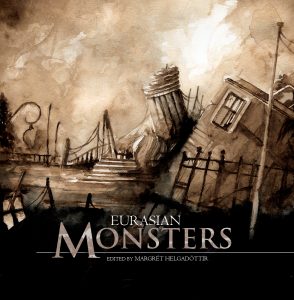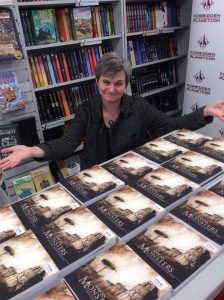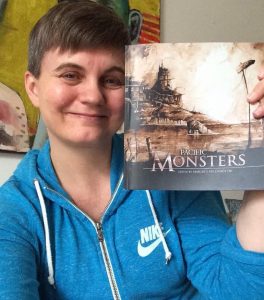The editor’s blog – Eurasian Monsters

The seventh and final volume of Fox Spirit Books of Monsters is out December 20th. The journey started in Europe in 2014 before it continued to Africa, Asia, the Pacific region, then the South, Central and North America. The series has been like a grand world tour exploring old myths, folklore and monster tales continent by continent. Sadly, most travels must have an end, and we close up our journey with a stop in Eurasia.

In Eurasian Monsters you’ll find tales of beasties and monstrous terror from the part of Eurasia stretching from the Chinese border (but not including China) to Eastern parts of Europe. I am proud to present you stories told by seventeen authors who are either from, have lived in, or have another strong connection to Russia, Ukraine, Georgia, Kazakhstan, Moldova, Poland, Hungary, and Bulgaria.
Not only do I wish to scare people with monsters they probably have never heard about. I also want the books to give the readers a realistic insight into the continents we cover—it is a journey after all. By returning to the place of origin, by giving authors who grew up with stories of these dark creatures a chance to write about them and own cultures, I hope these books give readers a glimpse of a contemporary, everyday life that is seldom seen by most of the West.
In Eurasian Monsters you’ll find tales about loneliness, living in a harsh climate, and everyday struggle—be it on the streets of Moscow or Varna, at a hospital in Elista, or in a nightclub in Tbilisi, in the forests of Poland, or in the Altai mountains. You’ll find stories with an underlying critic of aspects of society, be it poverty, illegal working or the life of immigrants, border conflicts, the relationship between east and west, or the tension between a traditional life and a modern society.
I’m pleased to tell that we have as many as seven translated stories in this book, six are exclusively translated for this volume—from Russian, Ukrainian and Polish. I believe the book is much better when these tales are included—and I hope that the translators are just as happy as I am with the stories. The translations also make it possible for me to introduce you to authors that not many in the Western parts of the world know about, there’s even a few who has never been translated to English before.
So why monsters books? Fox Spirit Books of Monsters came out of a discussion seven years ago, where myself and a few others, including my co-editor of the two first monster volumes, Jo Thomas, demanded that something had to be done. We felt that most monsters are forgotten today, while the rest are watered down and overused in the popular media, and then only a few of them dominate the scene—vampires, werewolves, ghouls, demons, zombies—and they are almost all from Western popular culture.
In these books we wish to re-establish the monsters’ dark reputation, to give them a comeback. I want to drag them out from the darkest corners, to show how many great monsters we have from all over the world. And we want them visible in the middle of people’s homes, as coffee table books with lush art. Happily Adele Wearing at Fox Spirit Books liked our ideas, and the first book about Europe quickly developed into the world series of seven volumes, one each year.

I am sad to now see the end of my story hunt around the world. Reading these tales has taught me that every country and region in the world has wonderful dark and eerie stories about monsters or dark creatures, some of them maybe thousands of years old. You can find traces of them in old texts and even in old sea maps. Monster folklore is passed down from generation to generation, and these stories are important in traditions and customs. The tales serve not only as entertainment, but often teach a lesson as well.
Some monsters are universal. You will always find the shapeshifters, the flesh-eating walking dead and the great monsters of the lakes and sea. But what is important to one culture might not be so vital to another. When I have edited the monster books I’ve tried to see if I can spot a specific pattern in each book, be it a main theme or the choice of monsters. I don’t know if it is a coincidence or a proof that there are geographical differences, but I do believe I’ve spotted some variations between the continents. To mention a few: Magic is one strong theme in monster narratives from Africa and Latin America, for instance, though it manifests in slightly different ways. The volumes focused on Africa and the Pacific region have more beasts, when compared to the other volumes in the series. These two volumes also have a multitude of dark creatures from the wilderness or oceans, or natural forces, such as hail storms or thunder storm. This is also the case in Eurasian Monsters, where especially the thick forests and the mountains are a natural habitat for several dark beings.
Quite many of the stories in Eurasian Monsters take place in the home, however, and wow, the bedroom and kitchen are some truly haunted places. There are also several stories about people and monsters forced to leave their homeland, and so origin gets a strong meaning, just like in the Africa volume. I feel however that this volume is closer to the feeling of home created in the Asian Monsters book—especially regarding those creatures hailing from the folklore of Slavic cultures—and the bond between the living and the dead, whether it is the soul of dead children or dead ancestors.
I hope you will like this volume as much as I have while working on it.
The monster volumes have been such fun books to edit. I wish to give huge thanks to all the authors and artists. I would also like to extend a warm thank you to Adele Wearing at Fox Spirit Books for believing in this idea to begin with, and all the work she and her wonderful crew have done for so many years in creating such great books.
Margrét Helgadottir

3 Replies to “Monsters Blogs : Editor’s Blog”
Comments are closed.